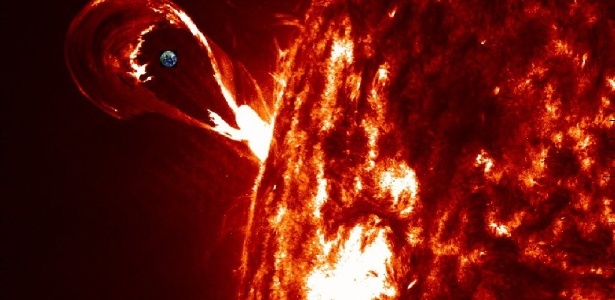It’s only a matter of time before Earth is hit again by a solar storm. In 1859, the planet already experienced the largest record of its kind: the Carrington event. At that time, telegrams around the world stopped working.
Today, such a storm can destroy electrical and communication systems around the world.
To protect the planet, we must:
- encourage research into the effects of these storms,
- Install devices (transformers) that protect vulnerable equipment
- Develop strategies to adjust grid loads when solar storms are about to occur.
It should be noted that these storms occur when a large bubble of extremely hot gas, known as plasma, escapes from the surface of the Sun and hits the Earth. The bubble is called a coronal mass expulsion.
Plasma consists of a cloud of protons and electrons, which are electrically charged particles, which upon reaching Earth interact with the magnetic field that surrounds the planet. This interaction leads to a distortion and weakening of the magnetic field, which increases the chances of natural phenomena.
What are solar (or geomagnetic) storms?
Since the beginning of the 19th century, it has become possible to find records of these types of phenomena. Scientific data from Antarctic ice core samples still show evidence of a more massive geomagnetic storm in AD 774 known as the Miyake event.
The explosion in question produced the largest and fastest increase in carbon-14. In general, geomagnetic storms are capable of releasing large amounts of cosmic rays into the atmosphere, which in turn produces carbon-14, a radioactive isotope of carbon.
There was another geomagnetic storm. This time, it’s 60% younger than the Miyake event of AD 993. Ice samples showed that large-scale geomagnetic storms of similar intensity to the Miyake and Carrington events occur every 500 years on average.
The National Oceanic and Atmospheric Administration is working with the Geomagnetic Storm Scale to measure the strength of these solar flares. The so-called “G scale” has a rating from 1 to 5, with G1 being minor and G5 extreme. The Carrington event could have been classified as a G5.
consequences of the storm
Today, a solar storm like the Carrington event can be disastrous, affecting all electrical systems. This phenomenon generates induced currents flowing through the electrical network.
One hundred amperes is equivalent to the electrical service that is provided to many homes. Currents of this magnitude can cause damage to internal components and widespread power outages.
A geomagnetic storm three times smaller than the Carrington event occurred in Quebec, Canada, in March 1989. During the storm, high magnetically induced currents damaged a transformer in New Jersey, United States, and tripped network breakers, leaving five million people without power for nine hours.
In addition to electrical failures, communications can be disrupted on a global scale, with outages from Internet service providers, television, navigation (GPS) and phone service problems.
In addition, increased solar activity causes the atmosphere to expand, which changes the density of the atmosphere where satellites orbit. The high-density atmosphere creates drag on the satellite, which slows it down and, if not maneuvered into a higher orbit, can be destroyed on return to Earth.
* With information from the conversation

“Incurable thinker. Food aficionado. Subtly charming alcohol scholar. Pop culture advocate.”






More Stories
NASA Releases Selfie of Perseverance Rover Working on Mars
NVIDIA driver includes hidden Final Fantasy XVI profile
PlayStation Plus Extra and Premium saw a significant drop in players in July